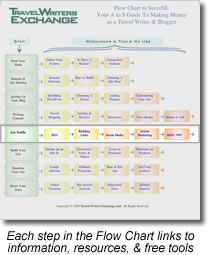If you’re wondering what this Case Study is all about, please read the introductory post from Week One.
Last week we discussed some simple tweaks Suzy made to her travel blog to increase its “search engine friendliness”, which in turn will increase the number of people who can find her site by using search engines.
This week we’ll outline a few basic methods that Suzy is using to build inbound links to her travel blog, which will do two things for her: 1) People will follow those links to her site, and 2) the more links she has to her site, the more “important” the search engines will believe it to be, and the higher in the results she’ll rank for searches using her keywords.
However, there is a BIG caveat with inbound links – namely, relevancy. In order to be most beneficial, inbound links should be from relevant sites, and have relevant, keyword-rich text both surrounding the link, and in the link’s anchor text.
For example, if your travel niche is traveling with pets, then a link from other sites about traveling with pets, or sites about travel, or sites having anything to do with pets, would all be considered relevant. A link from a site about car insurance is not. Thus, although Suzy’s travel niche is a small one, she’s focused on connecting with those other travel blogs and related websites that are within her niche to build relationships and encourage links to her travel blog.
Likewise, if someone links to you by saying “check out this really cool site about traveling with pets” with the phrase ‘traveling with pets’ linking to your site, it’s relevant. If they link to you saying “for a cool blog written by my friend Jeremy, click here” with the words ‘click here’ linking to you, it’s not only not relevant, but the search engines will think that your site is about “click here”. Very few people search for the phrase “click here”. Ideally your keywords should be used as the “anchor text”, but if that isn’t possible, then at a minimum your keywords should be as close as possible to the link to your site, so that search engines can associate those keywords with your site.
So how do you get good relevant links to your site? The two best ways are:
- Write really good content, and other sites will want to link to you;
- Find relevant sites and ask for a link;
If you find a site that you like that is relevant to yours, email the site owner or webmaster. Tell them what you like about their site, why you think they should link to you, and ask them to do so. Be specific in how you want them to link to you. Give them the specific keyword phrase that they should use for the anchor text, rather than your website name (unless your site name also contains your primary keywords). If you have specific content on your site that you would like them to link to, give them that page’s URL. It’s customary to offer to link back to them, so ask if they would like a reciprocal link, how they would like the link to appear, and to what page on their site they’d like you to link to.
In my opinion those are the two best ways because those will be the types of links that search engines follow, as well as people. Although there are other ways to get links (see below), typically those links use what is called a “nofollow” attribute (see my previous post Eliminate NoFollow to Stimulate Conversation for more information about the NoFollow attribute). While people can – and do – follow such links, search engines do not. Nor do they “count” them when calculating your travel blog’s popularity. However, they are still worth pursuing since the more people that visit your site, the greater chance you’ll have of getting the good, “follow”, type of links from those people.
Additional ways to garner inbound links:
- Commenting on other travel blogs;
- Becoming active in relevant Forums;
- Writing Guest Blog posts for other travel blogs;
- Using the “trackback” feature on other travel blogs’ posts when you write about them and link to them;
If you take advantage of commenting and forum posting, be sure that you’re adding some value to the conversation taking place at that blog or forum – otherwise you’ll just appear spammy and may find your comments and posts removed (see our previous post 10 Secrets to Leaving a Comment on a Travel Blog for more good tips on commenting etiquette). Suzy does a great job with leaving very insightful, valuable comments around the travel blogosphere, and other people, including the blog owners, take note of that.
It does take some time and effort to build enough quality inbound links before you’ll see any significant increase in site traffic, but the good news is that with just a few minutes a day, as you’re surfing around to some of your favorite other travel blogs and forums, you can begin using some of these link building techniques to start attracting more visitors.
Stay tuned! Next week we’ll cover how Suzy is using Social Media Networking to also increase the traffic to her travel blog.
~Trisha
What other ways do you attract visitors to your travel blog? Share your tips!







Great advice. All of these are very useful. I have been working towards adding links in almost all of the suggestions. But I really do have to become more active in forums. Thanks for reminding me:)
As always, thanks for your kind words and feedback – I’m really glad that you’re finding this series useful!
Hi. I always heard that reciprocal links more or less cancelled each other out as far as SEO is concerned? Is this incorrect?
Hi Denise
Yes, that is incorrect. Reciprocal links have never been bad, but there was a number of sites that tried to ‘game the system’ early on and it was the irrelevancy that hurt them – not the links. Giving a ‘vote’ to a site by linking to them does not take away the vote they gave you by linking to you – as long as the links (both in and out) are relevant, they both count.
Thanks so much Trish. That information is very helpful. I’m looking forward to the next lesson!